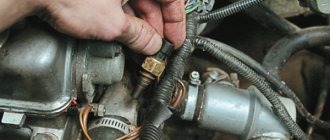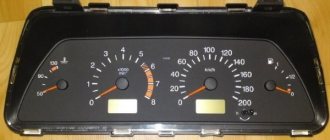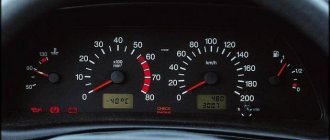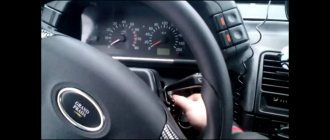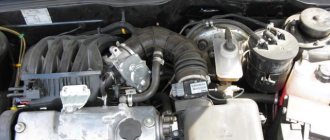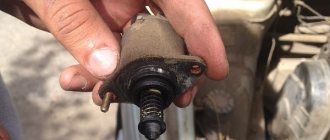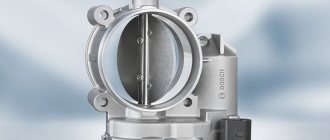The main causes of DTOZh breakdowns
There are several possible reasons why this sensor may stop working. Namely:
- there is no contact with the sensor;
- damage to wire insulation or broken contacts;
- systemically inoperative fan;
- complete failure of the device.
Symptoms of a malfunction in the DTOZH are:
- the car engine has not yet warmed up to its normal state, but the fan is already running;
- a well-warmed engine refuses to work;
- Gasoline consumption has increased significantly.
Remember, before you start checking the coolant temperature sensor, you need to make sure of its location.
This is done so as not to accidentally confuse this part with the coolant temperature indicator sensor.
Checking the performance of the DTOZH
In order to check the functionality of the above sensor, you must:
- Start the car and pay attention to the dashboard. If the temperature gauge shows the maximum value while the engine is still cold, you should disconnect all existing contacts from the temperature meter. If after this procedure the needle drops “from heaven to earth”, it’s time to replace the sensor.
- But if the needle remains at its maximum values, you need to pay attention to the sensor contact. Most likely, it was simply shorted to the mass of the car itself.
- If the engine warms up normally, but the needle either doesn't move at all or constantly jumps, it's time to check the fuses.
- If the fuses are in order, the contact should be closed to vehicle ground. If you notice that the arrow has jumped up, the problem lies in the performance of the temperature sensor.
There is another proven method, following which you need to perform the following actions:
- the multimeter is set to ohmmeter mode;
- We stock up on a thermometer that can show temperatures exceeding 100 degrees Celsius and a container that can withstand hot antifreeze;
- multimeter probes are attached to the output and the sensor body;
- the temperature sensor is disconnected and placed in a container into which coolant was previously poured;
- We monitor the readings of the thermometer and ohmmeter.
They should be combined like this:
Temperature reading: Ohmmeter reading:
If these indicators are not combined, we can safely say that the DTOZH is in a faulty condition.
If the DTOZH does not show the temperature of the VAZ-2114 engine, of course, you can try to replace it yourself. But this can only be done if you know at least a little about cars. Otherwise, it is best to contact a specialized service.
The fact is that the reasons for the breakdown of this part may be hidden in other, more serious problems in your car. For example, when checking the performance of the DTOZH, you accidentally removed the ignition module. And in order to correctly install it in its place, you need not only to try hard, but also to be a true master of your craft.
Having replaced the DTOZh in the service, you will receive not only high-quality work done, but also a guarantee for it. Each part of the car that was touched by the master’s hand will be placed in its proper place and securely fastened. If you try to save money and replace the DVT yourself, you can only incur additional costs. Remember, the miser pays twice.
Is the indicator not working or is it the temperature sensor?
There is one small but very insidious nuance in this matter. The fact is that both the pointer itself and the temperature sensor can fail. In the first case, the driver only receives unreliable instrument readings, which in most cases, if the car is in good condition and there are no faults in it, does not lead to serious consequences, however, it is a rather unpleasant breakdown.
However, if the DTOZH does not work, then the consequences can be much more dire. The thing is that modern cars are “stuffed” with electronics, which are designed to protect the car from possible breakdowns. The operation of all this electronics is based on sensors, and it is the data received from them that is the basis for generating signals to control mechanisms that correct the operation of vehicle components.
If the on-board computer receives incorrect data from them, then as a result it incorrectly regulates the operation of the vehicle components, which can lead to extremely unpleasant consequences. Therefore, if you have problems with engine temperature indicators, then first of all you need to decide whether the problem is in the temperature indicator or in the sensor.
Why does the VAZ-2114 not show the engine temperature?
Many motorists have encountered the fact that the temperature indicator arrow on the VAZ-2114 dashboard stopped showing, did not move from the zero position, or froze. But not everyone understands what causes this malfunction and how to fix it. In this article, we will consider possible options for the occurrence of such a breakdown and methods of elimination.
Video about diagnosing the temperature gauge (problem overview):
The video will tell you how to check and find the reason for the temperature gauge needle hanging up.
Causes of malfunction
Arrow stuck on dashboard
It’s probably no secret to anyone that the arrows hanging on the dashboard are inextricably linked with the electrical circuits in the car. To troubleshoot the problem, the car enthusiast will need some knowledge of auto electrics, as well as design knowledge of the VAZ-2114.
As practice shows, most motorists, when such a breakdown occurs, turn to a car service center, but this problem can be eliminated on their own. But, first of all, it is necessary to find the immediate cause of the effect.
What are the options?
So, let's look at the possible options for the engine temperature indicator arrow to hang on the dashboard:
- The magnetic motor of the pointer drive is broken.
- Breaks and disturbances in the operation of the electrical circuits of the dashboard.
- Short circuit in the circuit board of the device itself.
- Freeze related to temperature sensor.
- Problems with the ECU.
Elimination methods
Once the root causes have been identified, you can move directly to methods to resolve the problem.
To carry out repair and diagnostic operations, you will need some tools, namely: a multimeter, an OBD II cable, a tablet or laptop, as well as a set of keys and screwdrivers for dismantling the main and auxiliary components.
So, now that the motorist is fully armed, you can proceed directly to the diagnostic and repair process.
What's the result?
As you can see, there are a number of reasons why the temperature gauge does not rise and/or the engine does not reach operating temperature. At the same time, many drivers are concerned about the question of whether it is possible to drive if the engine does not heat up.
Also, the car may lose performance, fuel consumption increases, loaded components wear out more, engine oil ages faster, exhaust becomes more toxic, the service life of the catalyst decreases, etc.
It is quite obvious that in such a case it is necessary to stop active operation of the vehicle, not to subject the engine to loads, and also to carry out diagnostics and eliminate the malfunction at the first such opportunity.
The engine temperature does not rise, the internal combustion engine temperature needle drops while driving. Why does the temperature drop after turning on the stove? Diagnostics and repair, advice.
The engine does not reach operating temperature, the engine temperature arrow does not rise during warm-up or falls while driving: causes of the malfunction.
The engine warms up slowly at idle or while driving: why does this happen? Possible malfunctions of the cooling system, other reasons.
The engine temperature arrow jumps or jumps chaotically: the main reasons for this malfunction. Diagnosis of problems with your own hands, recommendations.
To warm up or not to warm up the engine in winter before driving. Why the engine should be warmed up, how to properly warm up the engine before driving and while driving.
What temperature of the coolant (antifreeze, antifreeze) is normal on a warm engine. What affects the boiling point and other properties of the coolant.
OPERATING PRINCIPLE AND DESIGN FEATURES
The VAZ 2114 coolant temperature sensor, for all its importance for the normal operation of the car, is a fairly simple device. DTOZH is a resistor with variable resistance, which changes as the temperature of the antifreeze in the system increases.
The sensor has only two contacts - the first of them transmits information about the current coolant temperature to the brains of the fourteenth, and the second sends a signal to turn on the fan (when the coolant temperature reaches a certain point).
Based on the received readings, the fourteenth ECU determines the composition of the fuel mixture supplied to the combustion chambers: the colder the engine, the richer the mixture. The coolant temperature affects how almost all engine control systems will operate: this data is taken into account when adjusting the ignition angle (the moment the spark is supplied for fuel combustion in the cylinders), the time the fan is turned on for forced cooling of the power unit, and much more.
The DTOZH is a fairly durable design; it rarely breaks down, but if the unit breaks down, its repair is impossible - the device must be replaced with a new one. The cost of DTOZh varies between 400-550 rubles. for domestically produced models (the VAZ 2115 coolant temperature sensor costs about the same).
TYPICAL SIGNS OF DTOZH BREAKAGE
Signs of a malfunction of the VAZ 2114 DTOZH are quite few in number and it is quite simple to determine that there are problems with the device. The following factors indicate a unit malfunction:
- The cooling fan of the power unit starts working when the ignition is turned on;
- Or it doesn’t want to turn on at all, even when the actual temperature of the engine is off the charts;
- Also, a breakdown is indicated by the indicator arrow on the instrument panel, which does not show the temperature of the VAZ 2114 engine (however, other reasons for a non-working indicator are also possible).
CHECKING SENSOR OPERATION
If any signs of a DTOZ malfunction are detected, you need to make sure that the problem lies directly in the device itself. To do this you need to do the following:
- We start the fourteenth and look at the dashboard; if, when the engine is cold, the indicator arrow shows the maximum temperature, you need to turn off the ignition, remove all contacts from the battery and disconnect the sensor power supply. Next, we connect the battery back and start the engine; if the indicator is at a minimum, the coolant temperature sensor does not work; if the indicator is at maximum, the problem must be looked for in the DTOZh contacts; perhaps they are not connected to the ground of the car;
- If, when the engine warms up, the coolant temperature gauge needle moves jerkily, most likely the problem is a blown fuse;
- If you have figured out the fuse and are sure that everything is in order with it, close the contacts of the device to the ground of the car; if the pointer has moved to the maximum, the coolant temperature indicator sensor on the VAZ 2114 needs to be changed.
A more accurate check of the coolant temperature sensor is performed using a multimeter that has an ohmmeter function. You can buy this device at any auto store for a small amount (about 400-600 rubles), which will cost you much less than checking the DTO at a service center.
To perform a test with a multimeter, the sensor must be dismantled; you can find out how to do this in the next section of the article. You will also need a kettle and a liquid thermometer that can withstand temperatures over 100 degrees.
Checking with a multimeter The check is performed according to the following algorithm:
- We switch the tester to ohmmeter mode and close the probes on the DTOZH contacts;
- Place the sensor in the kettle and start heating the water;
- Now you need to monitor and compare the water temperature and the readings on the multimeter screen. If the device is working properly, the indicators will be as follows:
If the actual data differs from the norm, the coolant sensor is faulty and must be replaced. In this way, it is recommended to check newly purchased devices before use, since factory defects are very common among domestically produced products.
Why the coolant temperature light may be on: opinions of car owners
1. The reasons may be different.
“When the temperature warning light starts flashing while the car is moving, you need to look at what level the coolant is. It is possible that the level is not high enough or the coolant has reached too high temperatures. It happens that the level remains within normal values and then it may make sense to check the operation of the fan fuse. If everything is in order there, then it’s better to go to the nearest workshop, trying to adhere to a low speed limit.”
2. The result is obvious.
“I was very concerned that the coolant temperature light was constantly on. In this case, there is no level sensor in the car. Following the advice posted on the forums, I removed the dashboard and soldered the connector and everything that was in doubt. As a result, the temperature light stopped blinking.”
3. I spent a lot of energy.
“I’ll share one story with you... I observed the coolant light blinking chaotically. It happened to burn at idle, and in motion, and at speed, and without. At times it stopped blinking.
As a result, the following actions were taken:
- The fuses have been checked and replaced.
- Checked belt tension.
- Checked coolant level.
- Due to the low level of antifreeze, a flushing and purging was done and the coolant was replaced.
- Replaced instrument panel
- Checked for leaks from the stove.
- Thermostat checked.
A lot of effort and time was spent on finding out the reason, but in the end everything turned out to be simpler - the cause of the light bulb turning out to be the wiring...”
4. Just tightened the nut.
“Not long ago I noticed that the coolant temperature light was on and blinking. At times the temperature sensor did not work. It turned out that the mass securing nut, which is located at the bottom of the engine, had become loose. When the motor was turned on, one end of the mass came into contact with the engine for forced passage of liquid, and the second generally clung to something incomprehensible. After I tightened the nut, the light bulb began to work as it should.”
SENSOR REPLACEMENT TECHNOLOGY
For safety reasons, replacing the coolant temperature sensor in a VAZ 2114 is done when the engine is cool, since the operating temperature of the antifreeze inside the system can reach one hundred degrees.
To remove the assembly you will only need open-end wrenches 19 and 8.
First, let's figure out where the coolant temperature sensor is located on the VAZ 2114. It is located in the engine compartment, not far from the cylinder head and thermostat. Access to the device is limited only by the air filter and it can be replaced fairly quickly.
Location of DTOZH Everything is done in the following sequence:
- Disconnect the negative terminal from the battery;
- Using a 8mm horn, unscrew the screws securing the air filter to the car body. Disconnect the MAF wire block and remove the air filter housing. Now access to DTOZH is not limited in any way;
- We remove the power from the DTOZH and use a 19 key to unscrew the sensor itself from the mounting socket.
It is not necessary to drain the antifreeze when replacing the unit; it only makes sense to do this if the scheduled replacement of the coolant is due.
Installation of a new coolant temperature indicator sensor is performed in the same way: screw the device into the mounting socket and tighten the thread with a 19-mm wrench. We connect the wiring to it and put the air filter in place, do not forget to connect the block of the MAF power supply wires.
It is strictly forbidden to seal the DTOZh seat with sealants, which is often recommended by would-be auto mechanics..
During operation of the power unit, the elements of the cooling system become very hot, especially the metal parts of the engine. The sealant applied to the threads will simply melt and get into the antifreeze, which can cause failure of the cooling system as a whole.
The procedure for replacing the sensor is simple, the main thing is to do everything step by step!
Does the engine on the VAZ 2114 get hot?
If the VAZ 2114 coolant temperature sensor stops working. What will happen to your car? That's right, the engine will simply boil. Engine overheating is an extremely undesirable problem that, unfortunately, many motorists face.
Coolant temperature detection element
Moreover, this sensor is inextricably linked with another device - DTOZH (coolant temperature sensor) . Its reliability leaves much to be desired.
Where is the coolant temperature sensor located?
There are three types of cooling system on cars:
- Mixed;
- Air;
- Liquid.
In the case of the VAZ 2114, we are dealing with the latest type of cooling system, which runs on liquid antifreeze or antifreeze.
The system itself includes the following components:
- Radiator fan;
- Radiator;
- Cooling radiator;
- Cooling system jacket;
- Pump;
- Expansion tank;
- Connection pipes;
- Coolant temperature sensor.
Breakdowns
The most popular and common breakdowns of DTOZH include:
- Lack of contact with the sensor;
- Break of contact, insulation disappears;
- The device stops working;
- The fan does not turn on when required.
It is also important to examine the signs of trouble. These include:
- The engine has not yet warmed up, but the fan is already starting to work;
- The engine has warmed up, but still does not work properly;
- Fuel consumption has increased significantly.
How to check
There are many cases in history when the owner installs a new spare part, but it does not work. Therefore, after purchasing a temperature sensor, it is recommended to measure the resistance before installing it on the same VAZ or another car. To do this you will need a multimeter (tester). We convert it to an ohmmeter. At room temperature (+23 °C, +25 °C), the readings should be around 2780 Ohms (as in table No. 1). If you lower the DTOZH into a glass of boiling water (+100 °C), hold it for a while and take readings, a result in the range of 175–180 Ohms should appear on the tester screen. This means the purchase is in good condition. Can be installed on a car.
Sensor check
Your VAZ 2114 engine overheats, or other signs of DTOZh failure appear. This suggests that you should check this element first.
There are two verification methods, each of which we will introduce you to.
First method
Removal
- Start the car, look at the dashboard. The gauge is at maximum, but the engine is still cold. Disconnect the contacts from the meter. If after this the arrow falls as far as possible, this indicates the need to replace the coolant temperature sensor on the VAZ 2114.
- If the arrow remains at the top, at the maximum level, take a closer look at the DTOZh contacts. Often they simply short circuit to the vehicle's ground.
- The engine may heat up normally, evenly, but the gauge needle jumps in different directions. Most likely the fuses have failed.
- If the fuses are good, close the contact to ground. If the arrow immediately jumps up, then the temperature sensor has failed.
Method two
- Take a multimeter and turn it on in ohmmeter mode.
- Arm yourself with a thermometer with notches over 100 degrees Celsius.
- Prepare heat-resistant containers that will not deform due to hot coolant.
- Connect the probes of the device to the sensor terminal and the housing.
- Having connected the DTOZH, place it in a container with coolant and begin heating.
- Monitor the ohmmeter and thermometer readings at the same time.
The table shows readings that correspond to a working, serviceable sensor. Using this method, you can check the condition of the new sensor before installing it in place of the old one.
| Temperature, C | Resistance, Ohm |
| 30 | 1350-1880 |
| 50 | 585-820 |
| 70 | 280-390 |
| 90 | 155-196 |
| 110 | 87-109 |
Temperature and fuel gauge glitches
The VDO instrument panel does not work. Temperature and fuel levels are “buggy”
Incorrect temperature and fuel readings? Probably many owners of VAZ 2110 - 2115 have already encountered the problem of incorrect display of fuel and temperature indicator on the VDO instrument panels, “Ch. Vladimir.
The actual engine temperature is 90 degrees (we know this for sure), but on the instrument panel it shows 110 degrees. There are 10 liters of gasoline in the tank, but the instrument panel shows either 20 liters, then 15 liters, and sometimes correctly 10 liters. Moreover, usually the tachometer and speed always show the correct values. I had this problem for about a whole year. When I test the instrument panel (Press the daily mileage button - hold it down, turn on the ignition, all instrument indicator arrows deviate over the entire scale span and the LCD segments are completely filled, and the emergency fuel level warning lamp lights up. When testing the instrument panel, the temperature indicator should smoothly go a distance from 50 degrees to 130 degrees. The fuel level should smoothly go a distance from 0 to 1). If the pointers work correctly during the test, then the problem is electronics. Car service centers say that these instrument panels cannot be repaired. Just buy a new one of the same instrument panel and everything will be fine. It was a pity to spend money on a new VDO instrument panel (about 2,400 rubles), since the engine speed and speed of the car were shown, the temperature was monitored on the STATE 510 trip computer, and when refueling I had to set the gasoline in the same way on the standard computer. It was read theoretically from the controller. By the way, the calculation was quite accurate, but it was annoying to constantly put out gasoline.
By the way, here is another main feature that confused me, the fact is that the temperature gauge began to jump strongly when the car’s lights, low beam, etc. were turned on.
Recently I decided to tackle this problem and fully understand it. I didn’t really believe that it was an electronics failure. The solution turned out to be very simple. In fact, it was just necessary to bring a good “ground” to the instrument panel. Or just restore the default one. After all the ground connections, the instrument panel began to work correctly. The temperature and fuel gauges now work accurately, even with the lights, heaters, etc. on.
All the “grounds” that need to be checked are described below: A fragment of the article taken from the site www.chiptuner.ru
The first ground connection of the vehicle is located inside the instrument panel, on the top left of the relay and fuse mounting block, under the sound insulation. On cars of the first years of production, the ground wires to the welded stud were approached on top of the sound insulation, and then someone’s bright mind came up with the idea of hiding the wires under it. So access to the stud is very inconvenient and is only possible using a tube wrench or an extended 10-mm socket. If there is insufficient connection in this place, when you turn on the headlights or electric window motors, the windshield wiper and washer may turn on, and the central door locking system may work.
The second connection is located on a welded stud, on the center console of the instrument panel, on the left side, above the left console screen, under the M6 nut.
But even if this nut is tightened properly, and the problem remains, then we move on to the most important point of mass for the entire instrument panel, grounding the entire metal frame of the panel. This is a welded stud with M6 thread. It is located on the lower, inner (cabin) side of the engine shield, in the middle. The nut screwed onto this stud also secures the bracket that secures the front part of the left screen of the console, which some diagnosticians and electricians mercilessly remove due to the fact that there are frequent cases of damage to the ECM harness or central locking system on this bracket. As a rule, the nut is tightened very, very mediocre. If there is insufficient contact in this and the previous connection, when turning on the side lights, headlights and radiator fan motor, deviations of the temperature and fuel level indicator arrows are possible.
Procedure for removing DTOZH
Twisting
You understand perfectly well that the coolant is called that for a reason. And if antifreeze boils in the expansion tank of a VAZ 2114, can this be considered normal? Not at all. It is not uncommon that the problem lies precisely in a faulty DVT.
To replace it, you need to perform several sequential steps.
- Drain the coolant. To do this: Wait until the engine has cooled down if you have just driven into the garage;
- Arm yourself with ring wrenches for 17, 13 and 8;
- Take a container into which the coolant will be drained;
- Remove the engine protection, disconnect the radiator fasteners;
- Turn on the stove to maximum mode and open the heater tap along with the expansion tank cap;
- Place a container under the radiator and very carefully begin to unscrew the drain plug. High pressure releases antifreeze from the expansion tank of the VAZ 2114, so you need to act slowly;
- Over the course of 10 minutes, the liquid will gradually drain;
- At this time, go to the engine, place the same container under it and unscrew the plug from the cylinder block, which is located directly under the ignition module;
- You will have to wait about 10 more minutes for the liquid to drain out.
- Find it on your car;
- We purchase a new TOZh sensor;
If after these manipulations the DTOZH still does not work, pay attention to several points:
- You may have screwed the new sensor into its seat poorly;
- It is possible that you forgot to fill the coolant;
- A leak of cooling liquid formed in the system, the generator was splashed with it;
- The new sensor could be defective. In this case, it is recommended to always leave the purchase receipt until you are sure that the sensor is working properly. Unfortunately, it is impossible to verify this on site.
Not all issues can be resolved on your own, no matter how experienced an auto mechanic you are. Sometimes you have to go to a service station. But here, too, you must be sure that the specialists are competent, their equipment is in good working order, and they have enough experience in order to efficiently solve the problem that you and your car have. Make good friends at car repair shops. Even if you visit them once a year.
